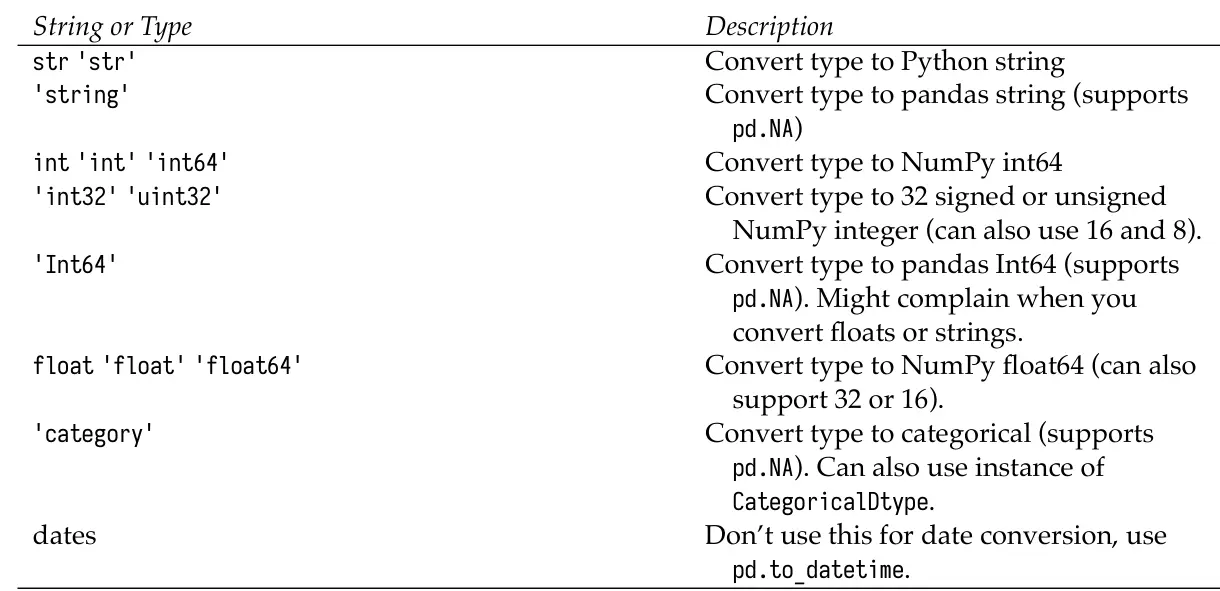数据分析神器Pandas快速入门3类型转换
pythontesting 2024-07-01 08:09:01 阅读 58
序列类型转换

3.1 自动转换
在pandas 1.0 中,引入了一种新的转换方法.convert_dtypes。它会尝试将Series 换为支持 pd.NA 类型。以city_mpg 系列为例,它将把类型从int64转换为Int64:
>>> city_mpg.convert_dtypes()
0 19
1 9
2 23
3 10
4 17
..
41139 19
41140 20
41141 18
41142 18
41143 16
Name: city08, Length: 41144, dtype: Int64
>>> city_mpg.astype('Int16')
0 19
1 9
2 23
3 10
4 17
..
41139 19
41140 20
41141 18
41142 18
41143 16
Name: city08, Length: 41144, dtype: Int16
>>> city_mpg.astype('Int8')
Traceback (most recent call last):
...
要指定系列数据的类型,可以尝试使用.astype 方法。我们的城市里程可以保存为16位整数,但8位整数就不行了,因为该符号类型的最大值是127,而我们有一些汽车的值是150。使用更窄的类型,就能减少内存使用,从而有更多内存处理更多数据。可以使用NumPy来检查整数和浮点类型的限制:
>>> np.iinfo('int64')
iinfo(min=-9223372036854775808, max=9223372036854775807, dtype=int64)
>>> np.iinfo('uint8')
iinfo(min=0, max=255, dtype=uint8)
>>> np.finfo('float16')
finfo(resolution=0.001, min=-6.55040e+04, max=6.55040e+04, dtype=float16)
>>> np.finfo('float64')
finfo(resolution=1e-15, min=-1.7976931348623157e+308, max=1.7976931348623157e+308, dtype=float64)
参考资料
- 软件测试精品书籍文档下载持续更新 https://github.com/china-testing/python-testing-examples 请点赞,谢谢!
- 本文涉及的python测试开发库 谢谢点赞! https://github.com/china-testing/python_cn_resouce
- python精品书籍下载 https://github.com/china-testing/python_cn_resouce/blob/main/python_good_books.md
- Linux精品书籍下载 https://www.cnblogs.com/testing-/p/17438558.html
3.2 内存使用
要计算系列的内存使用情况,可以使用.nbytes属性或.memory_usage方法。后者在处理object类型时非常有用,因为可以通过deep=True来计算系列中 Python 对象的内存使用量。
>>> city_mpg.nbytes
329152
>>> city_mpg.astype('Int16').nbytes
123432
autos的make列包含字符串,并作为对象存储。要获得包含字符串的内存量需要使用.memory_usage 方法:
>>> make = df.make
>>> make.memory_usage()
KeyboardInterrupt
>>> make.nbytes
329152
>>> make.memory_usage()
329280
>>> make.memory_usage(deep=True)
2606395
.nbytes只是数据正在使用的内存,不含序列的辅助部分。.memory_usage包括索引内存,还可能包括object类型的等。
3.3 字符串和分类
如果向 .astype 方法传递str,它还可以将数字序列转换为字符串
>>> city_mpg.astype(str)
0 19
1 9
2 23
3 10
4 17
..
41139 19
41140 20
41141 18
41142 18
41143 16
Name: city08, Length: 41144, dtype: object
>>> city_mpg.astype(str)
0 19
1 9
2 23
3 10
4 17
..
41139 19
41140 20
41141 18
41142 18
41143 16
Name: city08, Length: 41144, dtype: object
分类序列对字符串数据非常有用,可以节省大量内存。这是因为当你有字符串数据时pandas会存储Python字符串。
当你将其转换为分类数据时,pandas不再为每个值使用Python字符串,而是对其进行优化,因此重复值不会重复。您仍然可以使用.str 属性的所有功能,但可能会节省大量内存(如果您有很多重复值)并提高性能,因为您不需要执行那么多字符串操作。
3.4 有序分类
要创建有序分类,需要定义自己的 CategoricalDtype:
>>> values = pd.Series(sorted(set(city_mpg)))
>>> city_type = pd.CategoricalDtype(categories=values,
... ordered=True)
>>> city_mpg.astype(city_type)
0 19
1 9
2 23
3 10
4 17
..
41139 19
41140 20
41141 18
41142 18
41143 16
Name: city08, Length: 41144, dtype: category
Categories (105, int64): [6 < 7 < 8 < 9 ... 137 < 138 < 140 < 150]
下表列出了可以传入 .astype 的类型。

3.5 其他类型
.to_numpy方法(或.values属性)返回NumPy数组,而.to_list返回Python列表。一般不要使用这些方法。如果直接使用 NumPy,有时会提高速度,但也有缺点。使用Python列表会大大降低代码速度。
如果你只想要单列的数据帧,你可以使用.to_frame 方法:
>>> city_mpg.to_frame()
city08
0 19
1 9
2 23
3 10
4 17
... ...
41139 19
41140 20
41141 18
41142 18
41143 16
[41144 rows x 1 columns]
此外,还有许多将数据导出为其他格式的转换方法,包括 CSV、Excel、HDF5、SQL、JSON 等。这些方法也存在于数据帧中,在序列中应用不多。
要转换为日期时间,请使用pandas中的 to_datetime 函数。如果要添加时区信息,则需要更多步骤。有关日期的章节将对此进行讨论。
声明
本文内容仅代表作者观点,或转载于其他网站,本站不以此文作为商业用途
如有涉及侵权,请联系本站进行删除
转载本站原创文章,请注明来源及作者。